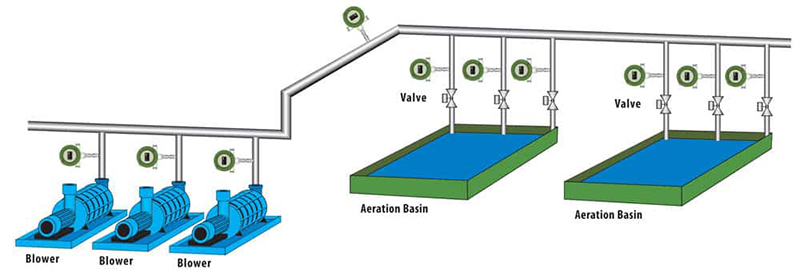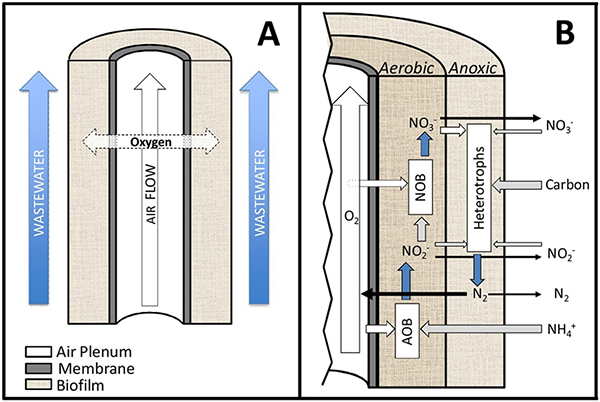Aeration is a critical step in wastewater treatment, particularly in the biological treatment processes where oxygen is supplied to microorganisms that break down organic pollutants, converting them into less harmful byproducts like carbon dioxide, water, and biomass.
The process typically occurs in aeration tanks, where air is either diffused into the water through submerged diffusers or mixed using mechanical aerators. Aeration not only helps remove organic matter but also aids in the removal of nitrogen and phosphorus through biological processes. However, aeration is also one of the most energy-intensive operations in wastewater treatment plants (WWTPs), accounting for 50-60% of the total energy consumption.
In the quest for more sustainable and cost-effective wastewater management, innovations in energy-efficient aeration technologies have gained significant momentum. This article explores the latest developments and best practices in aeration technology, designed to minimize energy use while maximizing treatment efficiency.
Why Aeration is Energy-Intensive?
Aeration systems introduce oxygen into the wastewater to support the metabolic processes of aerobic microorganisms. Traditional systems like mechanical surface aerators or diffused aeration systems require substantial energy to operate, primarily due to the energy demands of air compressors and blowers that generate the required airflow. The efficiency of this process largely depends on the ability to transfer oxygen from the air into the water— a challenge due to the relatively low solubility of oxygen in water. As energy costs rise and environmental sustainability becomes a priority, reducing the energy intensity of aeration has become a focal point for innovation.
Innovations in Aeration Technology
Fine Bubble Diffusers
One of the most significant advancements in aeration technology is the development of fine bubble diffusers. Unlike traditional coarse bubble systems, fine bubble diffusers generate smaller air bubbles, which provide a larger surface area for oxygen transfer. This results in higher oxygen transfer efficiency (OTE), reducing the amount of air—and energy—required for effective aeration. Fine bubble systems also minimize turbulence, enhancing the interaction between oxygen and wastewater, leading to more efficient biological processes.

High-Efficiency Blowers
The advent of high-efficiency blowers has revolutionized how air is delivered to the aeration tanks. Technologies such as turbo blowers and magnetic bearing blowers have drastically improved the energy efficiency of the process. Turbo blowers, for instance, operate with variable speed control, adjusting air delivery in real time based on the oxygen demand of the treatment process. Magnetic bearing blowers eliminate the mechanical friction typically found in conventional blowers, allowing for higher energy efficiency and longer equipment lifespan.

Oxygen Control and Monitoring Systems Automated oxygen control systems
Oxygen Control and Monitoring Systems Automated oxygen control systems equipped with sensors and software are now widely used to optimize aeration efficiency. These systems continuously monitor dissolved oxygen (DO) levels in real time, adjusting the airflow and blower speed as needed. By preventing over-aeration and under-aeration, these systems ensure that only the necessary amount of energy is used. Smart controllers integrated with SCADA (Supervisory Control and Data Acquisition) systems provide plant operators with detailed data to fine-tune operations, further enhancing energy efficiency.
Membrane Aerated Biofilm Reactors (MABR)
One of the more revolutionary developments in wastewater treatment is the introduction of Membrane Aerated Biofilm Reactors (MABR). These systems use gas-permeable membranes that allow oxygen to diffuse directly into a biofilm where microorganisms degrade pollutants. Because oxygen is delivered directly to the microbial community rather than through the water, MABR systems achieve significantly higher oxygen transfer efficiency while using less energy than conventional methods. MABRs also provide enhanced nitrogen removal, a critical need in modern wastewater treatment.

Jet Aeration Systems
Jet Aeration combines liquid recirculation with air injection to create a high-shear mixing environment. These systems are highly effective in terms of oxygen transfer efficiency and energy savings. By delivering air in short bursts and mixing it rapidly with wastewater, jet aerators reduce the overall amount of air needed, resulting in lower energy consumption compared to traditional mechanical aerators.

Hybrid Aeration Systems
Hybrid aeration systems integrate multiple aeration technologies to optimize energy use across different phases of the treatment process. For example, a plant might use coarse bubble aeration during peak loads and switch to fine bubble or membrane systems during periods of low demand. This flexibility allows for a more efficient use of energy, adapting to varying treatment conditions.

